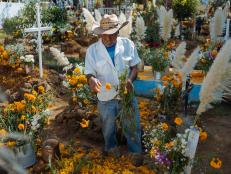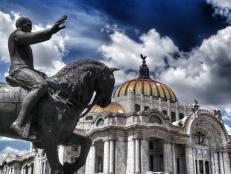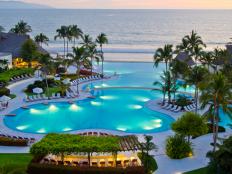What It's Like to Celebrate Day of the Dead in Mexico
This spirited holiday honors the departed and celebrates life. Just don't call it Halloween.
Related To:

Photo By: Lynn Coulter
Photo By: Vivo Resorts
Photo By: Alex Krotkov
Photo By: Lynn Coulter
Photo By: Lynn Coulter
Photo By: Lynn Coulter
Photo By: Gvozdik Dmitriy/Alex Krotkov
Photo By: Alex Krotkov
Photo By: Lynn Coulter
Photo By: Gvozdik Dmitriy/Alex Krotkov
Costumes and Painted Faces
No, it's not a Mexican version of Halloween. Dia de los Muertos, the Day of the Dead, has nothing to do with collecting treats. It's a celebration to honor the departed and remind the rest of us to enjoy our time on Earth. Revelers often wear costumes and masks or paint their faces with skull designs. The skulls, or Calaveras, aren't meant to frighten. They combine Aztec, Spanish Catholic and All Saints' Day elements to help us see death as just another phase of life—and even poke a little fun at it.
Resort Festivities
The Day of the Dead is usually observed Oct. 31 through Nov. 2 throughout Mexico and by people of Mexican heritage in other parts of the world. Puerto Escondido, a small town on Oaxaca's southern coast, celebrates with some of the country's best festivities. Altars and graves are decorated, locals and visitors don costumes and parties are held. Vivo Resorts, shown here, hosts brass bands that play as celebrators dine, dance and parade around the beachfront pool.
Day of the Dead Altars
During the holiday period, Dia de los Muertos altars are set up in private homes and in public, but they're not altars for worship. They hold foods to entice the deceased to visit, such as tamales, pan de muerto (bread for the dead) and beverages that range from water to beer to orange soda. An altar for a beloved pet might offer a bag of dog treats, bowls of kibble and fresh water and a favorite toy. Arches of leaves or flowers are often placed over the altars, representing the entrance to the world of the dead.
Offerings for the Departed
Altars also hold other kinds of gifts and offerings, such as sugar skulls (decorated sweets made of sugar paste), papier-mache skeletons, figures of saints, small toys and photos. Candles are lit to guide the spirits back to the community, and copal, an incense, is sometimes burned. Altars can have several levels. Three levels, for example, symbolize earth, purgatory and heaven.
La Calavera Catrina
A skeleton wearing a fancy dress, boa and big hat is an icon for the Day of the Dead. Known as La Calavera Catrina, she was inspired by an etching made by a Mexican artist in the early 1900s. Meant to satirize the snobby upper class, she reminds us that we're all the same under our clothes and that we can have fun and even laugh at our mortality.
Benito Juarez Market
Mercado Benito Juarez is a market near Puerto Escondido where shoppers can find almost anything they need for Day of the Dead meals and parties, including fresh sea bass and red snapper, string cheese, moles, mezcal, chapaulines (seasoned grasshoppers) and banana leaves for cooking tamales. The market is also a good place to buy souvenir textiles, leather goods, handmade crafts and Oaxacan clay pottery.
Marigolds and Other Flowers
Freshly cut flowers don't last long, but they're used to decorate altars and graves during the Day of the Dead, and they remind festival-goers that life is short. Vendors sell bouquets of fresh marigolds, along with roses, chrysanthemums, lilies and many other flowers, at the Juarez market. Their bright colors and pungent scents are believed to guide spirits back home.
Celebrating in Bajos de Chila
Make the short drive from Puerto Escondido to Bajos de Chila to see how locals celebrate Dia de los Muertos. In the evenings, you'll be welcomed into a crowd of families with children and invited to follow a band of tuba players, drummers and trombonists as they parade through the streets. Bring a few pesos to buy sweets from the pushcarts in the throng; it gets bigger and bigger as people pour out of their homes to join the fun.
Fantastical Characters
Costumes worn during the Day of the Dead festivities have probably led many people to confuse it with Halloween. Originally, celebrators wore brightly colored, traditional folk costumes. Today, they might wear camo jackets and carry plastic mallets, like this parade leader in Bajos de Chila. Don't be surprised if you're pulled out of the crowd by one of these fantastical characters for a lively dance; they don't mind if you'd rather watch.
Joining the Celebration
Visitors can get their faces painted at many hotels and resorts or at street stands in town, but remember: This holiday honors the departed, so be mindful of cultural traditions and beliefs.
After Dia de los Muertos, you'll find more to do in Puerto Escondido. Come back for surfing and bodyboard tournaments at Zicatela Beach (rated among the world's top surfing spots, it's just one of the area's many beautiful beaches). Take an eco-tour to see crocodiles, birds or bioluminescent organisms in Manialtepec Lagoon, or visit a coffee farm or artisan shop. Sip a cocktail at sunset at Espadin, a restaurant overlooking spectacular Carrizalillo Beach. Be sure to look for wild sea turtles, too. They're protected by Mexican laws, but resorts like Vivo fund conservation efforts and can often help you arrange to see some hatchlings.
's colorful, vibrant celebration of Mexico and its rich heritage. "Luzia" is filled with references to Mexican cinema, art, handicraft, religion and history including the bright yellow orb that reappears throughout the production; the Disk of Luzia. A central feature of the Cirque du Soleil Luzia production is the Disk of Luzia. The disk references the sun, the moon and the Aztec calendar. But the disk also pays tribute to the Teotihuacan archeological site which features some of the most architecturally notable Mesoamerican pyramids of the pre-Columbian Americas built around 100 C.E.](http://travel.home.sndimg.com/content/dam/images/travel/fullrights/2017/10/4/0/CI_Matt-Beard-Disk-of-Luzia.jpg.rend.hgtvcom.231.174.suffix/1507124891533.jpeg)





